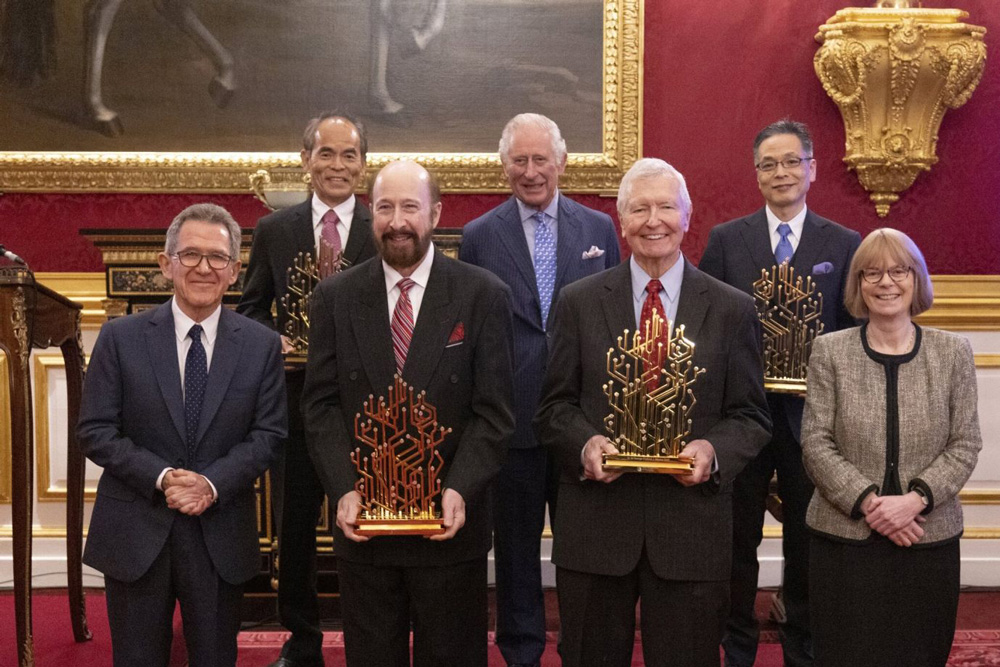News: LEDs
21 December 2021
QEPrize awarded to Akasaki, Nakamura, Holonyak, Craford and Dupuis
On 8 December, His Royal Highness The Prince of Wales presented the 2021 Queen Elizabeth Prize for Engineering in a ceremony at St James’s Palace in London, UK. The 2021 QEPrize laureates Isamu Akasaki, Shuji Nakamura, Nick Holonyak Jr, M. George Craford and Russell Dupuis are recognised for the creation and development of LED lighting, not only for the global impact of LED and solid-state lighting but also for the contribution that the technology has made - and will continue to make - to reducing energy consumption and addressing climate change.
Professor Akasaki passed away in April but was represented at the ceremony by his son-in-law Dr Kazuaki Takahashi. The Prince of Wales presented each winner with a gold trophy, whose designer and winner of the 2021 Create the Trophy competition, Hannah Goldsmith, was in attendance.

Picture: Back row (left to right) professor Shuji Nakamura, HRH The Prince of Wales, Dr Kazuaki Takahishi. Front row (left to right) Lord Browne of Madingley, professor Russell Dupuis, Dr George Craford, professor Dame Lynn Gladden. (Image credit: Jason Alden/QEPrize).
The QEPrize celebrates engineering’s visionaries, encouraging engineers to help extend the boundaries of what is possible across all disciplines and applications. It also aims to inspire young minds to consider engineering as a career choice and to help to solve the challenges of the future.
Visible LEDs are now a global industry predicted to be worth over $108bn by 2025 through low-cost, high-efficiency lighting. LED lighting is 75% more energy efficient than traditional incandescent and compact fluorescent bulbs, and is playing a crucial role in reducing carbon dioxide emissions. LED bulbs last 25 times longer than incandescent bulbs and their large-scale use reduces the energy demand required to cool buildings.
“This is a team prize. I was able to do what I did in the 1980s because of what had come before,” comments professor Nakamura. “When I was modifying reactors every morning and every afternoon continuously for a year and a half, I never thought it would be so successful,” he adds.
“I am proud to part of something that has made such a big impact on the world,” says Dr Craford.
“All five of us each played an important role... In those early days, when it was long days and nights hand-building reactors, Nick Holonyak mentored us. He really drew us in and inspired us,” comments professor Dupuis.
“This year’s Prize winners have not only helped humanity to achieve a greater degree of mastery over the environment, they have enabled us to do so in a sustainable way. They have created a product which we now take for granted, but which will play a major role in ensuring that humanity can live in harmony with nature for many more centuries to come,” stated Lord Browne of Madingley, chairman, Queen Elizabeth Prize for Engineering Foundation.
“The impact of this innovation is not to be understated. It makes lighting a lot cheaper and more accessible for emerging economies,” notes professor Sir Christopher Snowden, chair of the 2021 QEPrize Judging Panel. “For example, LEDs are being used on fishing boats where previously the only option would have been paraffin lamps. They are much cheaper and safer. It is not only an extreme engineering achievement, but a societal one that has a significant impact on the environment.”
The QEPrize is administered by the Queen Elizabeth Prize for Engineering Foundation and funded by support from the following corporate donors: BAE Systems plc, BP plc, GlaxoSmithKline, Hitachi Ltd., Jaguar Land Rover, National Grid plc, Nissan Motor Corporation, Shell UK Ltd, Siemens UK, Sony, Tata Steel Europe, Tata Consultancy Services, and Toshiba. The 2021 winners are awarded a total cash prize of £1m.








